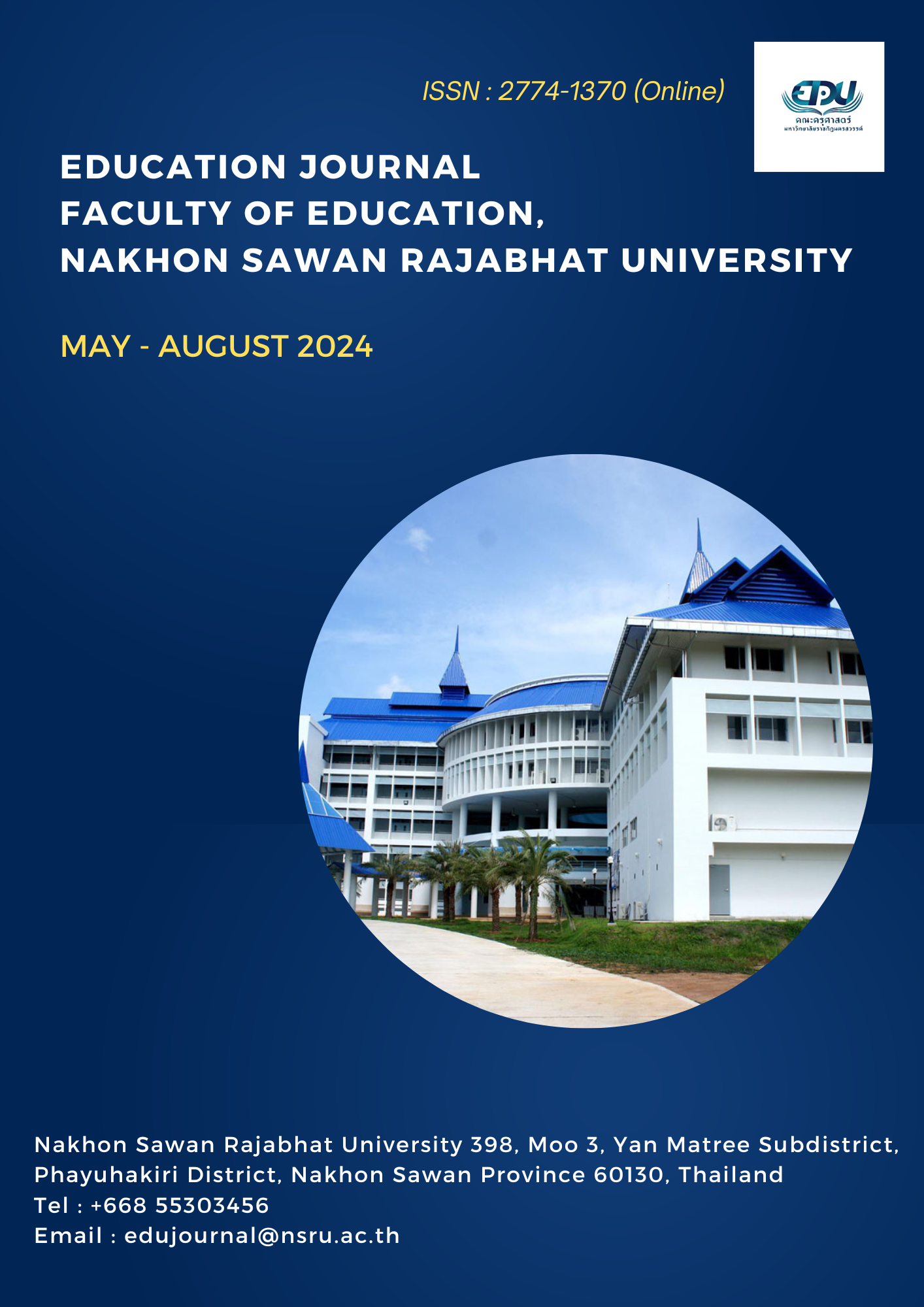Developing of Learning Achievement in Mathematics subject group using Active Learning 6-steps Method of adding two numbers with a sum not exceeding 9 of Students Prathom Suksa 1 Ban Nong Chum School
Main Article Content
Abstract
The objectives of this study were to 1) create and find out the effectiveness of the active learning plan 2) Find the effectiveness of active learning 3) Compare the achievement of active learning 6 steps before and after class and 4) Develop attitudes and desired characteristics in active learning in processing time: 1 semester. The sample used was 13 students, obtained through purposive sampling. The research tools were 1) pre test - post test, 2) student behavior observation form, 3) assessment form attitudes and desired characteristics of students and 4) Development tools include 12 plans. Statistics used include percentages, means and standard deviations, t-test Dependent
The research results found that 1) Effectiveness of the active learning plan E1/E2 value was 86.14/83.42, indicating that the skill training was more effective than the set criteria of 75/75. 2) Effectiveness of active learning progress scores accounted for 81.94 percent. 3) Results of comparing the achievement of active learning the average score of the pre-test was 4.32 points and the average score after the test was 7.86 points. After learning is higher than before learning. They are significantly different at the .05 level. 4) Attitude in active learning overall was at the highest level use teaching media in a fun and interesting way. basic knowledge of students is measured before class and helping children study slowly and promoting children respectively As for the desired characteristics overall at the level good and excellent when considering each item, it was found that discipline and commitment to work and the eagerness to learn aspect were at the good and excellent levels. and group and individual learning behavior has a quality level that passes the criterion
Keywords: Academic achievement; Active Learning; Skills training
Downloads
Article Details

This work is licensed under a Creative Commons Attribution-NonCommercial-NoDerivatives 4.0 International License.
References
กระทรวงศึกษาธิการ. (2557). หลักสูตรแกนกลางการศึกษาขั้นพื้นฐาน พุทธศักราช 2551. กรุงเทพฯ : โรงพิมพ์ไทยอักษร.
เกียรติกมล ทองงอก และโชติกา ภาษี. (2564). ผลการจัดกิจกรรมการเรียนรู้คณิตศาสตร์เชิงรุกร่วมกับการวินิจฉัยจุดบกพร่องในการเรียน ที่มีต่อผลสัมฤทธิ์ทางการเรียนและความสามารถในการแก้ปัญหาทางคณิตศาสตร์ของนักเรียนชั้นประถมศึกษาปีที่ 6. วารสารการวัดผลการศึกษา มหาวิทยาลัยมหาสารคาม, 27(1), 116-134. https://so02.tci-thaijo.org/index.php/jemmsu/article/view/243892/168268
จิณห์วรา พิมพ์แสง และพัชรินทร์ สะตะ (2565). การพัฒนาแผนการจัดการเรียนรู้โดยใช้วิธีการแบบเปิดกลุ่มสาระการเรียนรู้คณิตศาสตร์ เรื่อง การบวกและการลบจํานวนที่ผลลัพธ์ไม่เกิน 10 สําหรับนักเรียนชั้นประถมศึกษาปีที่ 1. วารสารครุศาสตร์ปัญญา, 1(6), 16-30. https://so06.tci-thaijo.org/index.php/IEJ/article/view/263027/176378
จุฑามาศ แกล้วทนงค์ กรวิภา สรรพกิจจำนง. (2564). การเปรียบเทียบผลสัมฤทธิ์ทางการเรียนวิชาคณิตศาสตร์ เรื่องการคูณของนักเรียนชั้นประถมศึกษาปีที่ 2 ระหว่างการสอนโดยใช้สื่อประสม ชุด การคูณแสนสนุก กับ การสอนแบบปกติ. Journal of Roi Kaensarn Adcdemi, 7(4), 362-373. https://so02.tci-thaijo.org/index.php/JRKSA/article/view/253178/172008
ธราเทพ ศรีลาโพธิ์ และอินทิรา รอบรู้. (2566). ผลสัมฤทธิ์ทางการเรียนภาษาอังกฤษของนักเรียนชั้นประถมศึกษาปีที่ 2 ที่เรียนด้วยกิจกรรมเรียนรู้เชิงรุก. วารสารนุษยศาสตร์และสังคมศาสตร์ มหาวิทยาลัยราชพฤกษ์, 9(1), 390-402. https://so03.tci-thaijo.org/index.php/rpu/article/view/267864/177413
นนทลี พรธาดาวิทย. (2559). การจัดการเรียนรูแบบ Active learning. พิมพครั้งที่ 2. กรุงเทพฯ : ทริปเพิ้ลเอ็ดดูเคชั่น.
บุญชม ศรีสะอาด. (2560). การวิจัยเบื้องต้น. ฉบับพิมพ์ครั้งที่ 10 แก้ไขเพิ่มเติม. กรุงเทพฯ : สุวีริยาสาสน.
พวงรัตน์ ทวีรัตน์. (2530). การสร้างและพัฒนาแบบทดสอบวัดผลสัมฤทธิ์. กรุงเทพฯ : สำนักทดสอบทางการศึกษาและจัยวิทยา. มหาวิทยาลัยศรีนครินทรวิโรฒ ประสานมิตร.
พัสสกรณ์ วิวรรธมงคล และศิริรัตน์ ชาวนา. (2563). การศึกษาเจตคติต่อวิชาคณิตศาสตร์ของนักเรียนชั้นประถมศึกษาปีที่ 6 ที่ได้รับการจัดการเรียนรู้แบบเชิงรุก. วารสารครุศาสตร์ปริทรรศน์ คณะครุศาสตร์ มหาวิทยาลัยมหาจุฬาลงกรณราชวิทยาลัย, 7(3), 85-95. https://so02.tci-thaijo.org/index.php/EDMCU/article/view/243364/166442
ภัททิรา เดชฤกษ์ปาน สราญจิต อ้นพา ณัฐิกา สุริยาวงษ์ พัชรพล ชิดลม และมาเรียม นิลพันธุ์. (2565). การพัฒนาแบบรูปแบบการจัดการเรียนรู้ตามแนวคิดเชิงรุก เพื่อเสริมสร้างความสามารถในการสร้างนวัตกรรมทางคณิตศาสตร์สําหรับนักเรียนชั้นประถมศึกษาปีที่ 4. วารสารวิชาการสถาบันพัฒนาพระวิทยากร, 5(1), 1-15. https://so06.tci-thaijo.org/index.php/tmd/article/view/252432/171998
วิจารณ์ พานิช. (2555). วิถีสร้างการเรียนรู้เพื่อศิษย์ในศตวรรษที่ 21. กรุงเทพฯ: มูลนิธิสดศรี - สฤษดิ์วงศ์.
อติศักดิ์ สุดเสน่หา ทิพย์วิมล วังแก้วหิรัญ และพรทิพย์ อ้นเกษม. (2563). การศึกษาผลสัมฤทธิ์ทางการเรียนตามกระบวนการทางคณิตศาสตร์ด้วยชุดกิจกรรมการเรียนรู้ตามแนวคิด Active Learning สำหรับนักเรียนชั้นประถมศึกษาปีที่ 4. วารสารบัณฑิตวิจัย, 11(2), 123-136. https://so02.tci-thaijo.org/index.php/banditvijai/article/view/241132/166491
Dale Edgar. (1969). Audio-visual methods in Teaching. (3rd ed). New York: The Dryden Press.
Oden, Ayana, "Factors Predicting The Self-efficacy Of Instructional Coaches Of Mathematics In Urban Elementary Schools." Dissertation, Georgia State University, 2022. doi: https://doi.org/10.57709/28975862


